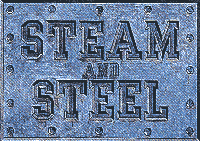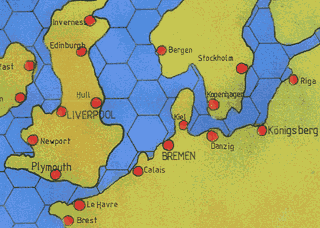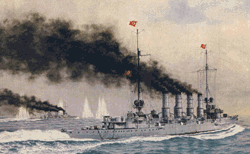 Contents:
Contents:
Author:
Lutz Pietschker
Version: 2001
Games | Home Page | Links | What's New
Whosoever commands the trade of the world, commands the riches of the world and hence the world itself. (Sir Walter Raleigh)
If the heart be right, it matters not which way the head lies. (the same, later, on the scaffold)
"Dampf und Stahl" is a game of naval power and economy; the objective is to gain the commercial and military superiority on the oceans. The crucial areas, or rather points, of the map are the ports, and the units at the player's disposal are his warships. The winner is the player that controls the largest port capacity at the end of the game, i.e. after a certain number of game turns or a predetermined time.
Players gain income from their ports. They spend their income for increasing port capacity, fortifying ports, building shipyards, and building ships. Ships have no inherent value towards the objective of the game, but they are necessary to protect the bases. New technology makes older ships obsolete, forcing players to constantly upgrade their fleets.
When opposing ships or fleets meet, or ships enter a fortified port, game play switches to short interludes of tactical battle.
Go back to the top
Go back to the top

Depending on the scenario played, each player starts with certain resources (ports, ships) in his possession. In most cases he has some freedom of choice what to buy with the available economy points. Scenario rules may also set the level of technology available and may limit the playable area. The "economy points" are the commodity everything revolves around; they are represented by game money.
The game is played in turns, each representing on year of real time and broken down into the following phases:
Technology advances in 6 levels (A to F); usually, "A" technology is all that the players may use at game start (1860). Each new step becomes available once certain required advances have been made. For example, to build "B" ships you need to know all of the "sandwiched armour", "hardened grenades", "twin-screw ship" and "gun turret" advances.
Not all ship classes are available at all times; for example, destroyers only become available at technology level D. Ships are distinguished by their attack and defence value, movement range, building cost, maintenance cost, and size (the latter determines the shipyard size needed, and construction time). The total available classes include, over the years: Battleships, battle cruisers, armoured cruisers, heavy and light cruisers, destroyers, torpedo boats, submarines, coastal defence ships, monitors, and aircraft carriers. Some classes have unique capabilities or shortcomings. For example, battle cruisers may conduct one "hit-and-run raid" per turn, i.e. one round of battle combat which is not subject to return fire, submarines and small craft are not allowed to capture ports on their own.
Port improvements are independent of technology. Most of the 140 ports on the map can generate income according to their size (5, 10, 20, 50 points for size 1, 2, 3, 4, respectively, representing in an abstract manner both the trade in the port and the merchant fleets that frequent it), but each port's growth is limited according to historical precedent. Any port may have forts and shipyards of any size. Forts, as you may expect, defend the port, alone or with the assistance of a fleet; the defence value depends on the size of the fort. Shipyards allow shipbuilding and major repairs, their size determines which number and types of ships may be built.
Ship movement is restricted by type-dependent movement point allowances; the hexes on the map are mainly there to count ranges, since nearly all action takes place in the port hexes and at certain choke points. Usually, ships have to reserve movement points for the return trip. The exceptions are "suicide attacks" (talk about Tsushima) and strategic relocation moves. The latter type of movement may even double the usual range if a stopover is made at a base. Patrol service, mine-laying and blockade service are special types of movement that aim at diminishing the value of a port, to avoid same, or to hinder passage through choke points (which requires both a previous sighting and winning the resulting battle to succeed).
Battles are resolved rather prosaically, in normal artillery combat there is no random element. Each ship fires on one opposing ship (alone or combined with other friendly ships), and the attack value is deducted from the opponent's defence value. A defence value of 0 (zero) means "sunk", fractional damage may possibly be repaired at turn end. Both sides fire simultaneously. An optional rule of the extension set allows to take artillery ranges into account. Special attack types (ramming, torpedoes etc.) are a bit different as they succeed only with a previous favourable die roll.
That's all there is to the game- rather enough to weigh heavily upon your mind even if the rules themselves are not complicated.
The unique angle on history that "Dampf und Stahl" provides are the technological advances you have to consider, and the passage of time. They raise the game above games like Risk and Diplomacy. No "instant armies" here, you have to plan in long terms in to win out!
Go back to the top
I can't really say a lot about strategy and tactics by now. The game obviously is one of balance between the economical strength to buy units and improvements and the military strength to protect them. The latter can be supplemented by skilled diplomacy, but as history teaches this can be deceptive in times of need.
The few games we played alternated between phases of consolidation, i.e. investing in existing bases, and expansion. The latter usually announces itself by increased shipbuilding activities and thus does not come as a complete surprise, though the direction it takes may well do so. Certain technological advances provide sudden opportunities, such as the opening of the Suez and Panama canals, and players do well to get to some kind of agreement how to handle these chances (and how to force others to stick to the agreement).
We found the games plays best with the optional rules included.
Go back to the top

The map is (colour-) printed on poster paper stock and folded to A4 size. Like with all such maps, it plays better when covered by a sheet of acrylic glass or so. Despite the few features present (ports, hexgrid-covered oceans) it looks rather nice and suits the purpose. The land masses are devoid of distinguishing features, as they play no role in the game. The rule suggests that you put your chips and beverages there, but we found them much more useful if we placed tables, charts or (self-made) play aids there.
The counters are printed on rather thin die-cut cardboard, about half the thickness of the "standard" cardboard counters we are used to from Avalon Hill et.al. They show the ship silhouette, type, class and an ID number. While the cardboard is superior to the customary fluffy grey stuff, their thin-ness made them a bit flimsy to stack and handle; this may, however, be a problem of my limited dexterity.
The rule book is a 32-page, A4 size affair in b/w photostat quality (the latter characteristic robs the photos in the book of some of their adorning quality), and in the 1st edition they are in German only. I am a stickler for detail, and I must confess that the spelling and grammar put me off a bit, but I have to admit they are consistent and rather well-organized, which should be the thing that matters. As far as we could see, all aspects of the game are explained, and the questions we still had were only about details or "just to make sure we got this right". Most points are further supported by examples. Tables and charts are included in the rule book, and you should copy them to keep them handy without excessive browsing.
One point I must mention is the amount of historical knowledge that obviously went into the development of this game. Each technological advance is described briefly not only in its effect on game play but also historically. Also, the counter mix and the availability of ship types reflects a more than superficial knowledge. There went more effort into this game than shows at first glance!
We found that the tables and log sheets leave some room for improvement, for example we made our own turn record track, big enough to stack counters of upcoming completions (ships and ports) there. We also organized the table of technological advances anew to easier keep track of what ship classes are actually available. These, however, are details, and very much according to our personal taste. To me they seem to simplify the book-keeping, which is a good thing since book-keeping is naturally a major part of the action in a game concerned with gaining and protecting assets. (Some of our play aids are available for downloading on this website.)
Go back to the top
A problem with the game as I encountered it was that it had been "sewn with a hot needle" in order to be ready for the Essen Games Fair, 1998. In a quick exchange of letters and e-mails with the author I cleared up a few points we were not quite sure about:
Go back to the top

I had the good luck to be notified of the very existence of the game by Holger Willert, owner of the Fantasy En'Counter games shop; I had the slightly bad luck to buy the game before the 2nd edition was ready. But despite some problems in playing the game "straight from the book" our group immediately consented that the concepts were straightforward and interesting, that the mechanics are sound and that the game was very much worth playing. If it gets honed at the edges a bit it will certainly become one of the games we take from the shelf whenever we feel an urge to "go imperial". If you are interested in the topic I recommend that you contact the author of the game and ask when the English version will be publicly available.
Go back to the top
Go back to the top
As the author of this page I take no expressed or implied responsibility for the content of external links; opinions expressed on such pages are not necessarily mine. The web space provider is not responsible for the contents of this page or any linked pages.
Written and published by Lutz Pietschker. Please send comments about technical problems to the
site master.
-Made with a Mac!-
, last change 2011-03-12